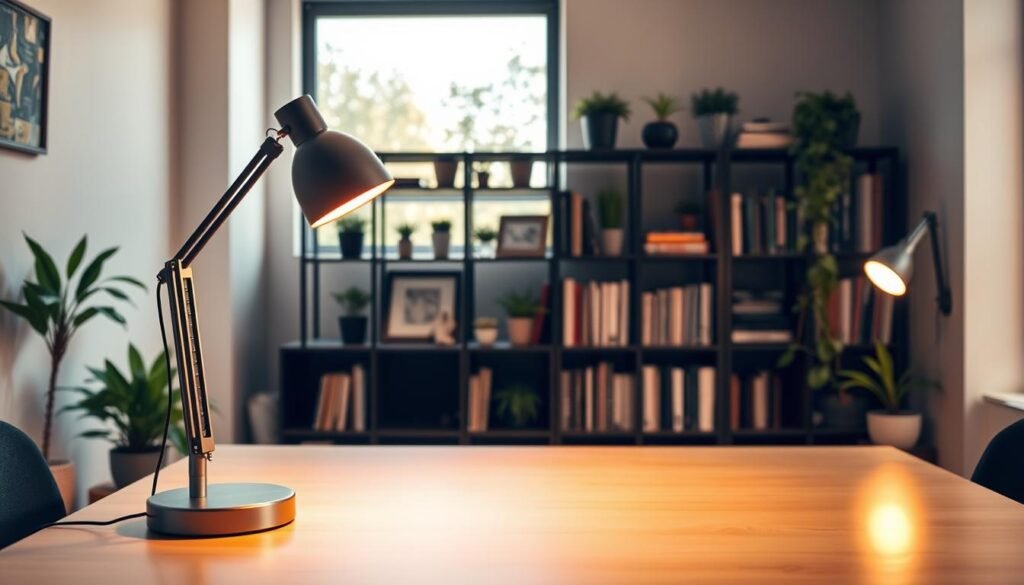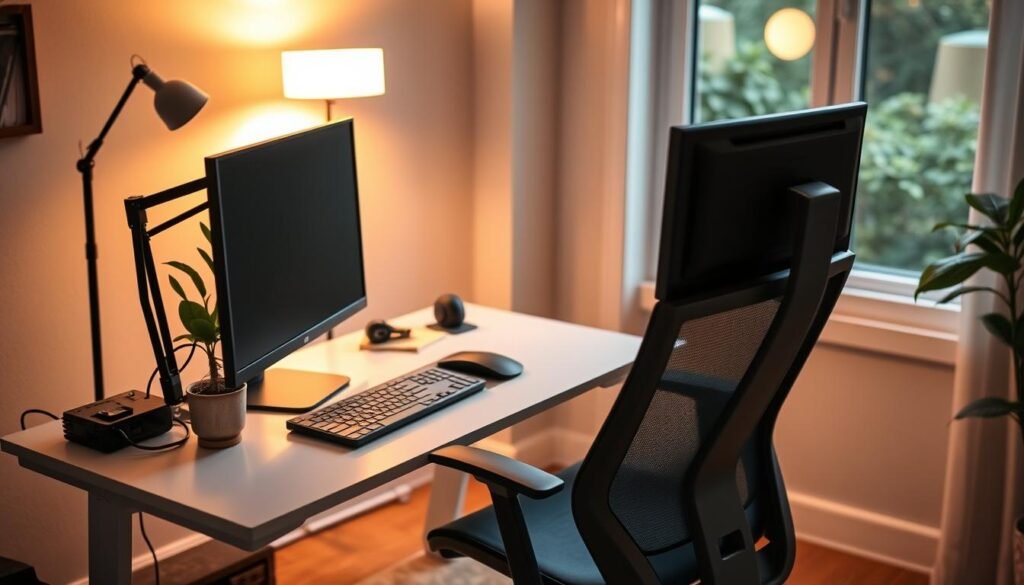Working from home brings flexibility, but distractions can quickly derail your progress. A well-planned workspace does more than provide a spot for your laptop—it shapes your mindset. Studies reveal that intentional design choices in your environment directly impact how you think, solve problems, and stay productive.
Modern professionals face unique challenges with remote and hybrid setups. Your physical space isn’t just about functionality—it’s a tool for unlocking creativity and sustaining momentum. From lighting to layout, every detail plays a role in maintaining mental clarity during long work hours.
This isn’t about perfection. It’s about crafting an environment that aligns with your goals. Whether you’re brainstorming ideas or tackling deadlines, your surroundings can either fuel your energy or drain it. Let’s explore how strategic design transforms ordinary areas into hubs of innovation.
Key Takeaways
- Your physical workspace directly affects mental performance and problem-solving abilities
- Remote work trends require rethinking traditional office setups for better efficiency
- Visual elements like lighting and organization boost creativity during tasks
- Intentional design supports both professional growth and personal well-being
- Productive environments balance functionality with inspiration-driven details
Understanding the Role of Your Workspace in Boosting Productivity
Your desk setup does more than hold your coffee mug—it shapes how your brain operates. Strategic design choices act like invisible productivity partners, helping you tackle tasks with fewer distractions. Let’s break down two game-changing elements you might overlook.
Sunlight: Your Secret Focus Weapon
Workers near windows get 173% more daylight, according to sleep researchers. This isn’t just about brightness—natural light regulates your body clock. Those extra 46 minutes of nightly sleep? They come from sunlight exposure during your workday.
Why Clutter Drains Your Brainpower
Messy desks aren’t just eyesores. A Journal of Environmental Psychology study found clutter competes for mental attention, like having ten browser tabs open. The result? 30% slower task completion and higher stress hormones.
| Factor | Cluttered Space | Organized Space |
|---|---|---|
| Focus Duration | 22 minutes avg. | 47 minutes avg. |
| Stress Levels | 40% higher cortisol | Baseline levels |
| Task Accuracy | 78% success rate | 94% success rate |
Try this: Spend five minutes daily tidying your workspace. Use drawer dividers for small items. You’ll notice clearer thinking within three days—your brain stops scanning the chaos.
Choosing the Right Location for Your Workspace
Your work environment’s geography shapes more than your commute time—it wires your brain for success. A strategic location acts like a productivity amplifier, filtering distractions while boosting mental stamina. Let’s explore how to find your ideal spot.
Evaluating Different Spaces at Home or Office
Start by auditing potential areas. Notice how sunlight dances across rooms at various times. Spaces near windows offer natural light that fights eye strain and keeps energy steady. Listen for refrigerator hums or street noise—these subtle sounds add up.
Test drive your top three choices. Spend Monday in the home office nook, Tuesday at the kitchen counter. Track where you finish tasks fastest. Notice which space makes you forget the clock.
| Location Factor | Home Advantage | Office Benefit |
|---|---|---|
| Noise Control | Quiet mornings | Professional acoustics |
| Light Quality | Personalized lighting | Consistent brightness |
| Privacy Level | Custom boundaries | Designated zones |
Benefits of a Dedicated and Private Area
A closed door does double duty—it mutes distractions and shouts “work mode activated” to your brain. Cornell researchers found workers in private rooms complete complex tasks 19% faster than those in open areas.
Choose a room that breathes. High ceilings spark creative thinking, while warm wall colors promote calm focus. Leave space for a standing desk or whiteboard—your future self will thank you.
Remember that corner you considered? Try this instead: Claim territory near a window but away from household traffic. Your workspace should feel separate from leisure zones, even in compact homes.
How to create a workspace conducive to focus and creativity
Your desk arrangement holds untapped potential to elevate both efficiency and imagination. The sweet spot lies in balancing self-expression with smart design—turning functional surfaces into idea incubators.

Curating Meaningful Desktop Elements
Strategic personalization turns your desk into a creativity launchpad. Try this: place three items that spark joy within arm’s reach—a vibrant notebook, textured pen holder, or miniature zen garden. Rotate motivational pieces weekly to prevent visual fatigue.
Research shows workers with personalized accessories complete tasks 18% faster. Keep inspirational triggers subtle—a framed quote tilted toward your chair or colored sticky notes for brainstorming sessions.
Lighting Layers That Work With You
Think beyond basic lamps. Combine overhead fixtures (ambient) with adjustable lighting (task) and decorative sconces (accent). This trio adapts to morning video calls and late-night crunch times.
| Light Type | Purpose | Ideal Placement |
|---|---|---|
| Ambient | Overall brightness | Ceiling fixtures |
| Task | Detailed work | Desk left/right side |
| Accent | Mood enhancement | Behind monitors |
Position task lamps at 10 o’clock for right-handed users to minimize shadows. Use smart bulbs to shift from energizing cool whites to warm sunset tones—your eyes will thank you during marathon sessions.
Essential Ergonomic Elements for a Healthy Work Environment
Your chair and desk aren’t just furniture—they’re your body’s support system during long work hours. Proper ergonomics prevent chronic pain while boosting efficiency. The Mayo Clinic reports that 50% of office workers experience musculoskeletal issues yearly, often from poor setup choices.

Smart Furniture Selection Saves Joints
Invest in an adjustable chair with lumbar support and breathable fabric. Look for armrests aligning with your desk height to prevent shoulder strain. Pair it with a sit-stand desk that remembers your preferred positions—this combo reduces back pressure by 32%.
| Feature | Traditional Desk | Ergonomic Solution |
|---|---|---|
| Height Adjustment | Fixed position | Electric or manual controls |
| Wrist Support | None | Keyboard tray with padding |
| Movement Options | Static sitting | Sit-stand alternation |
Daily Adjustments Matter
Position monitors at arm’s length with the top third at eye level. Keep elbows bent at 90° when typing—this prevents “mouse shoulder.” Use a footrest if your feet dangle; it improves circulation and reduces leg fatigue.
Try this quick check: Sit upright with shoulders relaxed. Your screen should feel like a natural extension of your gaze. Adjust your environment every 90 minutes—stand for calls or stretch during loading screens.
Incorporating Personal Touches to Inspire Creativity
Your surroundings whisper to your subconscious—what story do you want them to tell? Strategic personalization transforms sterile surfaces into idea factories. Let’s explore how colors, textures, and living elements shape your mental landscape.
Color Psychology in Action
Red accent walls boost urgency for deadline-driven tasks. Blue desk organizers promote calm during complex problem-solving. For creative brainstorming sessions, yellow throw pillows spark innovative thinking. Studies show:
| Color | Psychological Effect | Best Use |
|---|---|---|
| Red | Increases alertness | Task deadlines |
| Blue | Enhances focus | Deep work sessions |
| Yellow | Stimulates ideas | Creative projects |
Position colorful accessories where your eyes naturally rest. A crimson notebook beside your keyboard or cerulean curtains framing your view creates subtle psychological nudges.
Nature’s Productivity Boosters
Snake plants do double duty—they filter toxins while softening harsh office edges. Try clustering three small succulents near your monitor. Their organic shapes counterbalance tech-heavy environments, reducing stress by 17% according to NASA research.
Incorporate natural textures through walnut desk organizers or stone coasters. These elements ground your workspace in tactile reality, helping maintain flow states during virtual meetings.
Your favorite framed photo or that quirky mug collection? They’re not just decorations—they’re creativity triggers. Rotate meaningful items weekly to keep your inspiration fresh without visual overload.
Simple Strategies for Maintaining Organization and Decluttering
Clutter isn’t just messy—it’s a productivity thief stealing 15 minutes daily through misplaced items. Let’s transform your home office into an efficiency engine with smart systems that stick.
Storage Solutions That Actually Work
Start with vertical real estate. Monitor arms reclaim 30% of desk space—perfect for notebooks or that coffee mug you actually use daily. Try this setup:
| Problem Area | Smart Fix | Benefit |
|---|---|---|
| Cable Chaos | Adhesive trays under desks | Hidden power strips |
| Paper Piles | Wall-mounted file pockets | Quick access to docs |
| Small Items | Magnetic strips for tools | No more drawer diving |
Color-code storage bins by project type. Red for urgent tasks, blue for creative materials. Your brain will learn the system faster than you think.
Habit-Forming Decluttering Techniques
The “clean slate” method works wonders. Empty your entire workspace every 3 months. Only return items proving their worth through weekly use. For daily maintenance:
• Implement “one in, one out” rule for supplies
• Scan 3 documents after lunch daily
• Schedule 10-minute tidy-up before logging off
Digital organization matters too. Create cloud folders named “Action,” “Reference,” and “Archive.” Your future self will find files 60% faster during crunch times.
Conclusion
Crafting an effective workspace isn’t about radical overhauls—it’s about smart tweaks that compound over time. When lighting, furniture, and personal touches align, your home office becomes a launchpad for both productivity and original thinking. Hybrid work demands spaces that adapt—zones for deep focus today might host collaborative video calls tomorrow.
Balancing function with inspiration reduces mental fatigue. A plant-filled corner or color-coded storage system does more than look nice—it sustains momentum during long tasks. Studies prove organized environments help maintain 17% higher concentration levels compared to cluttered setups.
Your workspace should evolve as your needs shift. Test layouts seasonally—warm lighting for winter months, brighter accents when summer energy wanes. These intentional choices build a environment where professional growth and personal well-being coexist seamlessly.

![[create a workspace conducive to focus and creativity]](https://upgrademyfocus.com/wp-content/uploads/2025/07/create-a-workspace-conducive-to-focus-and-creativity.jpeg)